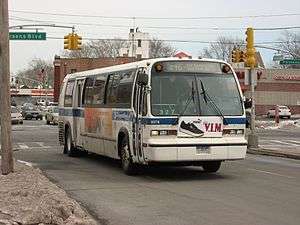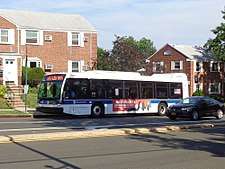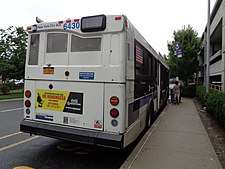Q46 (New York City bus)
The Q46 bus route constitutes a public transit line in Queens, New York City, running primarily along Union Turnpike from a major transfer with the IND Queens Boulevard Line subway in Kew Gardens to either Glen Oaks, or Long Island Jewish Hospital in Lake Success.
q46 | |||||||||||||||||||||||||||||||||||||||||||||||||||||||||||||||||||||||||||||||||||||||||||||||||||||||||||||||||||||||||||||||||||||||||||||||||||||||||||||||||||||||||||||||||||||||||||||||||||||||||||||||||||||||||||||||||||||||||||||||||||||||||||||||||||||||||||||||||||||||||||||||||||||||||||||||||||||||||||||||||||||||||||||||||||||||||||||||||||||||||||||||||||||||||||||||||||||||||||||||||||||||||||||||||||||||||||||||||||||||||||||||||||||||||||||||||||||||||||||||||||||||||||||||||||||||||||||||||||||||||||||||||||||||||||||||||||||||||||||||||||||||||||||||||||||||||||||||||||||||||||||||||||||||||||||||||||||||||||||||||||||||||||||||||||||||||||||||||||||||||||||||||||||||||||||||||||||||||||||||||||||||||||||||||||||||||||||||||||||||||||||||||||||||||||||||||||||||||||||||||||||||||||||||||||||||||
|---|---|---|---|---|---|---|---|---|---|---|---|---|---|---|---|---|---|---|---|---|---|---|---|---|---|---|---|---|---|---|---|---|---|---|---|---|---|---|---|---|---|---|---|---|---|---|---|---|---|---|---|---|---|---|---|---|---|---|---|---|---|---|---|---|---|---|---|---|---|---|---|---|---|---|---|---|---|---|---|---|---|---|---|---|---|---|---|---|---|---|---|---|---|---|---|---|---|---|---|---|---|---|---|---|---|---|---|---|---|---|---|---|---|---|---|---|---|---|---|---|---|---|---|---|---|---|---|---|---|---|---|---|---|---|---|---|---|---|---|---|---|---|---|---|---|---|---|---|---|---|---|---|---|---|---|---|---|---|---|---|---|---|---|---|---|---|---|---|---|---|---|---|---|---|---|---|---|---|---|---|---|---|---|---|---|---|---|---|---|---|---|---|---|---|---|---|---|---|---|---|---|---|---|---|---|---|---|---|---|---|---|---|---|---|---|---|---|---|---|---|---|---|---|---|---|---|---|---|---|---|---|---|---|---|---|---|---|---|---|---|---|---|---|---|---|---|---|---|---|---|---|---|---|---|---|---|---|---|---|---|---|---|---|---|---|---|---|---|---|---|---|---|---|---|---|---|---|---|---|---|---|---|---|---|---|---|---|---|---|---|---|---|---|---|---|---|---|---|---|---|---|---|---|---|---|---|---|---|---|---|---|---|---|---|---|---|---|---|---|---|---|---|---|---|---|---|---|---|---|---|---|---|---|---|---|---|---|---|---|---|---|---|---|---|---|---|---|---|---|---|---|---|---|---|---|---|---|---|---|---|---|---|---|---|---|---|---|---|---|---|---|---|---|---|---|---|---|---|---|---|---|---|---|---|---|---|---|---|---|---|---|---|---|---|---|---|---|---|---|---|---|---|---|---|---|---|---|---|---|---|---|---|---|---|---|---|---|---|---|---|---|---|---|---|---|---|---|---|---|---|---|---|---|---|---|---|---|---|---|---|---|---|---|---|---|---|---|---|---|---|---|---|---|---|---|---|---|---|---|---|---|---|---|---|---|---|---|---|---|---|---|---|---|---|---|---|---|---|---|---|---|---|---|---|---|---|---|---|---|---|---|---|---|---|---|---|---|---|---|---|---|---|---|---|---|---|---|---|---|---|---|---|---|---|---|---|---|---|---|---|---|---|---|---|---|---|---|---|---|---|---|---|---|---|---|---|---|---|---|---|---|---|---|---|---|---|---|---|---|---|---|---|---|---|---|---|---|---|---|---|---|---|---|---|---|---|---|---|---|---|---|---|---|---|---|---|---|---|---|---|---|---|---|---|---|---|---|---|---|---|---|---|---|---|---|---|---|---|---|---|---|---|---|---|---|---|---|---|---|---|---|---|---|---|---|---|---|---|---|---|---|---|---|---|---|---|---|---|---|---|---|---|---|---|---|---|---|---|---|---|---|---|---|---|---|---|---|---|---|---|---|---|---|---|---|---|---|---|---|---|---|---|---|---|---|---|---|---|---|---|---|---|---|---|---|---|---|---|---|---|---|---|---|---|---|---|---|---|---|---|---|---|---|---|---|---|---|---|---|---|---|---|---|---|---|---|---|---|---|---|---|---|---|---|---|---|---|---|---|---|---|---|---|---|---|---|---|---|---|---|---|---|---|---|---|---|---|---|---|---|---|---|---|---|---|---|---|---|---|---|---|---|---|---|---|---|---|---|---|---|---|---|---|---|---|---|---|---|---|---|---|---|---|---|---|---|---|---|---|---|---|---|---|---|---|---|---|---|---|---|---|---|---|---|---|---|---|---|---|---|---|---|---|---|---|---|---|---|---|---|---|---|---|---|---|---|---|---|---|---|---|---|---|---|---|
| Union Turnpike | |||||||||||||||||||||||||||||||||||||||||||||||||||||||||||||||||||||||||||||||||||||||||||||||||||||||||||||||||||||||||||||||||||||||||||||||||||||||||||||||||||||||||||||||||||||||||||||||||||||||||||||||||||||||||||||||||||||||||||||||||||||||||||||||||||||||||||||||||||||||||||||||||||||||||||||||||||||||||||||||||||||||||||||||||||||||||||||||||||||||||||||||||||||||||||||||||||||||||||||||||||||||||||||||||||||||||||||||||||||||||||||||||||||||||||||||||||||||||||||||||||||||||||||||||||||||||||||||||||||||||||||||||||||||||||||||||||||||||||||||||||||||||||||||||||||||||||||||||||||||||||||||||||||||||||||||||||||||||||||||||||||||||||||||||||||||||||||||||||||||||||||||||||||||||||||||||||||||||||||||||||||||||||||||||||||||||||||||||||||||||||||||||||||||||||||||||||||||||||||||||||||||||||||||||||||||||
 | |||||||||||||||||||||||||||||||||||||||||||||||||||||||||||||||||||||||||||||||||||||||||||||||||||||||||||||||||||||||||||||||||||||||||||||||||||||||||||||||||||||||||||||||||||||||||||||||||||||||||||||||||||||||||||||||||||||||||||||||||||||||||||||||||||||||||||||||||||||||||||||||||||||||||||||||||||||||||||||||||||||||||||||||||||||||||||||||||||||||||||||||||||||||||||||||||||||||||||||||||||||||||||||||||||||||||||||||||||||||||||||||||||||||||||||||||||||||||||||||||||||||||||||||||||||||||||||||||||||||||||||||||||||||||||||||||||||||||||||||||||||||||||||||||||||||||||||||||||||||||||||||||||||||||||||||||||||||||||||||||||||||||||||||||||||||||||||||||||||||||||||||||||||||||||||||||||||||||||||||||||||||||||||||||||||||||||||||||||||||||||||||||||||||||||||||||||||||||||||||||||||||||||||||||||||||||
| Overview | |||||||||||||||||||||||||||||||||||||||||||||||||||||||||||||||||||||||||||||||||||||||||||||||||||||||||||||||||||||||||||||||||||||||||||||||||||||||||||||||||||||||||||||||||||||||||||||||||||||||||||||||||||||||||||||||||||||||||||||||||||||||||||||||||||||||||||||||||||||||||||||||||||||||||||||||||||||||||||||||||||||||||||||||||||||||||||||||||||||||||||||||||||||||||||||||||||||||||||||||||||||||||||||||||||||||||||||||||||||||||||||||||||||||||||||||||||||||||||||||||||||||||||||||||||||||||||||||||||||||||||||||||||||||||||||||||||||||||||||||||||||||||||||||||||||||||||||||||||||||||||||||||||||||||||||||||||||||||||||||||||||||||||||||||||||||||||||||||||||||||||||||||||||||||||||||||||||||||||||||||||||||||||||||||||||||||||||||||||||||||||||||||||||||||||||||||||||||||||||||||||||||||||||||||||||||||
| System | MTA Regional Bus Operations | ||||||||||||||||||||||||||||||||||||||||||||||||||||||||||||||||||||||||||||||||||||||||||||||||||||||||||||||||||||||||||||||||||||||||||||||||||||||||||||||||||||||||||||||||||||||||||||||||||||||||||||||||||||||||||||||||||||||||||||||||||||||||||||||||||||||||||||||||||||||||||||||||||||||||||||||||||||||||||||||||||||||||||||||||||||||||||||||||||||||||||||||||||||||||||||||||||||||||||||||||||||||||||||||||||||||||||||||||||||||||||||||||||||||||||||||||||||||||||||||||||||||||||||||||||||||||||||||||||||||||||||||||||||||||||||||||||||||||||||||||||||||||||||||||||||||||||||||||||||||||||||||||||||||||||||||||||||||||||||||||||||||||||||||||||||||||||||||||||||||||||||||||||||||||||||||||||||||||||||||||||||||||||||||||||||||||||||||||||||||||||||||||||||||||||||||||||||||||||||||||||||||||||||||||||||||||
| Operator | New York City Transit Authority | ||||||||||||||||||||||||||||||||||||||||||||||||||||||||||||||||||||||||||||||||||||||||||||||||||||||||||||||||||||||||||||||||||||||||||||||||||||||||||||||||||||||||||||||||||||||||||||||||||||||||||||||||||||||||||||||||||||||||||||||||||||||||||||||||||||||||||||||||||||||||||||||||||||||||||||||||||||||||||||||||||||||||||||||||||||||||||||||||||||||||||||||||||||||||||||||||||||||||||||||||||||||||||||||||||||||||||||||||||||||||||||||||||||||||||||||||||||||||||||||||||||||||||||||||||||||||||||||||||||||||||||||||||||||||||||||||||||||||||||||||||||||||||||||||||||||||||||||||||||||||||||||||||||||||||||||||||||||||||||||||||||||||||||||||||||||||||||||||||||||||||||||||||||||||||||||||||||||||||||||||||||||||||||||||||||||||||||||||||||||||||||||||||||||||||||||||||||||||||||||||||||||||||||||||||||||||
| Garage | Queens Village Depot | ||||||||||||||||||||||||||||||||||||||||||||||||||||||||||||||||||||||||||||||||||||||||||||||||||||||||||||||||||||||||||||||||||||||||||||||||||||||||||||||||||||||||||||||||||||||||||||||||||||||||||||||||||||||||||||||||||||||||||||||||||||||||||||||||||||||||||||||||||||||||||||||||||||||||||||||||||||||||||||||||||||||||||||||||||||||||||||||||||||||||||||||||||||||||||||||||||||||||||||||||||||||||||||||||||||||||||||||||||||||||||||||||||||||||||||||||||||||||||||||||||||||||||||||||||||||||||||||||||||||||||||||||||||||||||||||||||||||||||||||||||||||||||||||||||||||||||||||||||||||||||||||||||||||||||||||||||||||||||||||||||||||||||||||||||||||||||||||||||||||||||||||||||||||||||||||||||||||||||||||||||||||||||||||||||||||||||||||||||||||||||||||||||||||||||||||||||||||||||||||||||||||||||||||||||||||||
| Vehicle | |||||||||||||||||||||||||||||||||||||||||||||||||||||||||||||||||||||||||||||||||||||||||||||||||||||||||||||||||||||||||||||||||||||||||||||||||||||||||||||||||||||||||||||||||||||||||||||||||||||||||||||||||||||||||||||||||||||||||||||||||||||||||||||||||||||||||||||||||||||||||||||||||||||||||||||||||||||||||||||||||||||||||||||||||||||||||||||||||||||||||||||||||||||||||||||||||||||||||||||||||||||||||||||||||||||||||||||||||||||||||||||||||||||||||||||||||||||||||||||||||||||||||||||||||||||||||||||||||||||||||||||||||||||||||||||||||||||||||||||||||||||||||||||||||||||||||||||||||||||||||||||||||||||||||||||||||||||||||||||||||||||||||||||||||||||||||||||||||||||||||||||||||||||||||||||||||||||||||||||||||||||||||||||||||||||||||||||||||||||||||||||||||||||||||||||||||||||||||||||||||||||||||||||||||||||||||
| Began service | 1939 1977 (Q44A limited-stop service) | ||||||||||||||||||||||||||||||||||||||||||||||||||||||||||||||||||||||||||||||||||||||||||||||||||||||||||||||||||||||||||||||||||||||||||||||||||||||||||||||||||||||||||||||||||||||||||||||||||||||||||||||||||||||||||||||||||||||||||||||||||||||||||||||||||||||||||||||||||||||||||||||||||||||||||||||||||||||||||||||||||||||||||||||||||||||||||||||||||||||||||||||||||||||||||||||||||||||||||||||||||||||||||||||||||||||||||||||||||||||||||||||||||||||||||||||||||||||||||||||||||||||||||||||||||||||||||||||||||||||||||||||||||||||||||||||||||||||||||||||||||||||||||||||||||||||||||||||||||||||||||||||||||||||||||||||||||||||||||||||||||||||||||||||||||||||||||||||||||||||||||||||||||||||||||||||||||||||||||||||||||||||||||||||||||||||||||||||||||||||||||||||||||||||||||||||||||||||||||||||||||||||||||||||||||||||||
| Route | |||||||||||||||||||||||||||||||||||||||||||||||||||||||||||||||||||||||||||||||||||||||||||||||||||||||||||||||||||||||||||||||||||||||||||||||||||||||||||||||||||||||||||||||||||||||||||||||||||||||||||||||||||||||||||||||||||||||||||||||||||||||||||||||||||||||||||||||||||||||||||||||||||||||||||||||||||||||||||||||||||||||||||||||||||||||||||||||||||||||||||||||||||||||||||||||||||||||||||||||||||||||||||||||||||||||||||||||||||||||||||||||||||||||||||||||||||||||||||||||||||||||||||||||||||||||||||||||||||||||||||||||||||||||||||||||||||||||||||||||||||||||||||||||||||||||||||||||||||||||||||||||||||||||||||||||||||||||||||||||||||||||||||||||||||||||||||||||||||||||||||||||||||||||||||||||||||||||||||||||||||||||||||||||||||||||||||||||||||||||||||||||||||||||||||||||||||||||||||||||||||||||||||||||||||||||||
| Locale | Queens | ||||||||||||||||||||||||||||||||||||||||||||||||||||||||||||||||||||||||||||||||||||||||||||||||||||||||||||||||||||||||||||||||||||||||||||||||||||||||||||||||||||||||||||||||||||||||||||||||||||||||||||||||||||||||||||||||||||||||||||||||||||||||||||||||||||||||||||||||||||||||||||||||||||||||||||||||||||||||||||||||||||||||||||||||||||||||||||||||||||||||||||||||||||||||||||||||||||||||||||||||||||||||||||||||||||||||||||||||||||||||||||||||||||||||||||||||||||||||||||||||||||||||||||||||||||||||||||||||||||||||||||||||||||||||||||||||||||||||||||||||||||||||||||||||||||||||||||||||||||||||||||||||||||||||||||||||||||||||||||||||||||||||||||||||||||||||||||||||||||||||||||||||||||||||||||||||||||||||||||||||||||||||||||||||||||||||||||||||||||||||||||||||||||||||||||||||||||||||||||||||||||||||||||||||||||||||
| Communities served | Kew Gardens, Kew Gardens Hills, Hillcrest, Fresh Meadows, Oakland Gardens, Bellaire, Glen Oaks, Floral Park | ||||||||||||||||||||||||||||||||||||||||||||||||||||||||||||||||||||||||||||||||||||||||||||||||||||||||||||||||||||||||||||||||||||||||||||||||||||||||||||||||||||||||||||||||||||||||||||||||||||||||||||||||||||||||||||||||||||||||||||||||||||||||||||||||||||||||||||||||||||||||||||||||||||||||||||||||||||||||||||||||||||||||||||||||||||||||||||||||||||||||||||||||||||||||||||||||||||||||||||||||||||||||||||||||||||||||||||||||||||||||||||||||||||||||||||||||||||||||||||||||||||||||||||||||||||||||||||||||||||||||||||||||||||||||||||||||||||||||||||||||||||||||||||||||||||||||||||||||||||||||||||||||||||||||||||||||||||||||||||||||||||||||||||||||||||||||||||||||||||||||||||||||||||||||||||||||||||||||||||||||||||||||||||||||||||||||||||||||||||||||||||||||||||||||||||||||||||||||||||||||||||||||||||||||||||||||
| Landmarks served | Queens Borough Hall, St. John's University, Creedmoor Psychiatric Center, Queens County Farm Museum, Queens Hospital Center | ||||||||||||||||||||||||||||||||||||||||||||||||||||||||||||||||||||||||||||||||||||||||||||||||||||||||||||||||||||||||||||||||||||||||||||||||||||||||||||||||||||||||||||||||||||||||||||||||||||||||||||||||||||||||||||||||||||||||||||||||||||||||||||||||||||||||||||||||||||||||||||||||||||||||||||||||||||||||||||||||||||||||||||||||||||||||||||||||||||||||||||||||||||||||||||||||||||||||||||||||||||||||||||||||||||||||||||||||||||||||||||||||||||||||||||||||||||||||||||||||||||||||||||||||||||||||||||||||||||||||||||||||||||||||||||||||||||||||||||||||||||||||||||||||||||||||||||||||||||||||||||||||||||||||||||||||||||||||||||||||||||||||||||||||||||||||||||||||||||||||||||||||||||||||||||||||||||||||||||||||||||||||||||||||||||||||||||||||||||||||||||||||||||||||||||||||||||||||||||||||||||||||||||||||||||||||
| Start | Kew Gardens – Queens Boulevard / Union Turnpike station | ||||||||||||||||||||||||||||||||||||||||||||||||||||||||||||||||||||||||||||||||||||||||||||||||||||||||||||||||||||||||||||||||||||||||||||||||||||||||||||||||||||||||||||||||||||||||||||||||||||||||||||||||||||||||||||||||||||||||||||||||||||||||||||||||||||||||||||||||||||||||||||||||||||||||||||||||||||||||||||||||||||||||||||||||||||||||||||||||||||||||||||||||||||||||||||||||||||||||||||||||||||||||||||||||||||||||||||||||||||||||||||||||||||||||||||||||||||||||||||||||||||||||||||||||||||||||||||||||||||||||||||||||||||||||||||||||||||||||||||||||||||||||||||||||||||||||||||||||||||||||||||||||||||||||||||||||||||||||||||||||||||||||||||||||||||||||||||||||||||||||||||||||||||||||||||||||||||||||||||||||||||||||||||||||||||||||||||||||||||||||||||||||||||||||||||||||||||||||||||||||||||||||||||||||||||||||
| Via | Union Turnpike | ||||||||||||||||||||||||||||||||||||||||||||||||||||||||||||||||||||||||||||||||||||||||||||||||||||||||||||||||||||||||||||||||||||||||||||||||||||||||||||||||||||||||||||||||||||||||||||||||||||||||||||||||||||||||||||||||||||||||||||||||||||||||||||||||||||||||||||||||||||||||||||||||||||||||||||||||||||||||||||||||||||||||||||||||||||||||||||||||||||||||||||||||||||||||||||||||||||||||||||||||||||||||||||||||||||||||||||||||||||||||||||||||||||||||||||||||||||||||||||||||||||||||||||||||||||||||||||||||||||||||||||||||||||||||||||||||||||||||||||||||||||||||||||||||||||||||||||||||||||||||||||||||||||||||||||||||||||||||||||||||||||||||||||||||||||||||||||||||||||||||||||||||||||||||||||||||||||||||||||||||||||||||||||||||||||||||||||||||||||||||||||||||||||||||||||||||||||||||||||||||||||||||||||||||||||||||
| End | Oakland Gardens – Springfield Boulevard (Rush hour local service) Glen Oaks – Little Neck Parkway & 260th Street (Glen Oaks Branch) Lake Success, Nassau County – Long Island Jewish Medical Center (full route) | ||||||||||||||||||||||||||||||||||||||||||||||||||||||||||||||||||||||||||||||||||||||||||||||||||||||||||||||||||||||||||||||||||||||||||||||||||||||||||||||||||||||||||||||||||||||||||||||||||||||||||||||||||||||||||||||||||||||||||||||||||||||||||||||||||||||||||||||||||||||||||||||||||||||||||||||||||||||||||||||||||||||||||||||||||||||||||||||||||||||||||||||||||||||||||||||||||||||||||||||||||||||||||||||||||||||||||||||||||||||||||||||||||||||||||||||||||||||||||||||||||||||||||||||||||||||||||||||||||||||||||||||||||||||||||||||||||||||||||||||||||||||||||||||||||||||||||||||||||||||||||||||||||||||||||||||||||||||||||||||||||||||||||||||||||||||||||||||||||||||||||||||||||||||||||||||||||||||||||||||||||||||||||||||||||||||||||||||||||||||||||||||||||||||||||||||||||||||||||||||||||||||||||||||||||||||||
| Service | |||||||||||||||||||||||||||||||||||||||||||||||||||||||||||||||||||||||||||||||||||||||||||||||||||||||||||||||||||||||||||||||||||||||||||||||||||||||||||||||||||||||||||||||||||||||||||||||||||||||||||||||||||||||||||||||||||||||||||||||||||||||||||||||||||||||||||||||||||||||||||||||||||||||||||||||||||||||||||||||||||||||||||||||||||||||||||||||||||||||||||||||||||||||||||||||||||||||||||||||||||||||||||||||||||||||||||||||||||||||||||||||||||||||||||||||||||||||||||||||||||||||||||||||||||||||||||||||||||||||||||||||||||||||||||||||||||||||||||||||||||||||||||||||||||||||||||||||||||||||||||||||||||||||||||||||||||||||||||||||||||||||||||||||||||||||||||||||||||||||||||||||||||||||||||||||||||||||||||||||||||||||||||||||||||||||||||||||||||||||||||||||||||||||||||||||||||||||||||||||||||||||||||||||||||||||||
| Operates | 24 hours[note 1][1] | ||||||||||||||||||||||||||||||||||||||||||||||||||||||||||||||||||||||||||||||||||||||||||||||||||||||||||||||||||||||||||||||||||||||||||||||||||||||||||||||||||||||||||||||||||||||||||||||||||||||||||||||||||||||||||||||||||||||||||||||||||||||||||||||||||||||||||||||||||||||||||||||||||||||||||||||||||||||||||||||||||||||||||||||||||||||||||||||||||||||||||||||||||||||||||||||||||||||||||||||||||||||||||||||||||||||||||||||||||||||||||||||||||||||||||||||||||||||||||||||||||||||||||||||||||||||||||||||||||||||||||||||||||||||||||||||||||||||||||||||||||||||||||||||||||||||||||||||||||||||||||||||||||||||||||||||||||||||||||||||||||||||||||||||||||||||||||||||||||||||||||||||||||||||||||||||||||||||||||||||||||||||||||||||||||||||||||||||||||||||||||||||||||||||||||||||||||||||||||||||||||||||||||||||||||||||||
| Annual patronage | 5,929,218 (2018)[2] | ||||||||||||||||||||||||||||||||||||||||||||||||||||||||||||||||||||||||||||||||||||||||||||||||||||||||||||||||||||||||||||||||||||||||||||||||||||||||||||||||||||||||||||||||||||||||||||||||||||||||||||||||||||||||||||||||||||||||||||||||||||||||||||||||||||||||||||||||||||||||||||||||||||||||||||||||||||||||||||||||||||||||||||||||||||||||||||||||||||||||||||||||||||||||||||||||||||||||||||||||||||||||||||||||||||||||||||||||||||||||||||||||||||||||||||||||||||||||||||||||||||||||||||||||||||||||||||||||||||||||||||||||||||||||||||||||||||||||||||||||||||||||||||||||||||||||||||||||||||||||||||||||||||||||||||||||||||||||||||||||||||||||||||||||||||||||||||||||||||||||||||||||||||||||||||||||||||||||||||||||||||||||||||||||||||||||||||||||||||||||||||||||||||||||||||||||||||||||||||||||||||||||||||||||||||||||
| Transfers | Yes | ||||||||||||||||||||||||||||||||||||||||||||||||||||||||||||||||||||||||||||||||||||||||||||||||||||||||||||||||||||||||||||||||||||||||||||||||||||||||||||||||||||||||||||||||||||||||||||||||||||||||||||||||||||||||||||||||||||||||||||||||||||||||||||||||||||||||||||||||||||||||||||||||||||||||||||||||||||||||||||||||||||||||||||||||||||||||||||||||||||||||||||||||||||||||||||||||||||||||||||||||||||||||||||||||||||||||||||||||||||||||||||||||||||||||||||||||||||||||||||||||||||||||||||||||||||||||||||||||||||||||||||||||||||||||||||||||||||||||||||||||||||||||||||||||||||||||||||||||||||||||||||||||||||||||||||||||||||||||||||||||||||||||||||||||||||||||||||||||||||||||||||||||||||||||||||||||||||||||||||||||||||||||||||||||||||||||||||||||||||||||||||||||||||||||||||||||||||||||||||||||||||||||||||||||||||||||
| Timetable | Q46 | ||||||||||||||||||||||||||||||||||||||||||||||||||||||||||||||||||||||||||||||||||||||||||||||||||||||||||||||||||||||||||||||||||||||||||||||||||||||||||||||||||||||||||||||||||||||||||||||||||||||||||||||||||||||||||||||||||||||||||||||||||||||||||||||||||||||||||||||||||||||||||||||||||||||||||||||||||||||||||||||||||||||||||||||||||||||||||||||||||||||||||||||||||||||||||||||||||||||||||||||||||||||||||||||||||||||||||||||||||||||||||||||||||||||||||||||||||||||||||||||||||||||||||||||||||||||||||||||||||||||||||||||||||||||||||||||||||||||||||||||||||||||||||||||||||||||||||||||||||||||||||||||||||||||||||||||||||||||||||||||||||||||||||||||||||||||||||||||||||||||||||||||||||||||||||||||||||||||||||||||||||||||||||||||||||||||||||||||||||||||||||||||||||||||||||||||||||||||||||||||||||||||||||||||||||||||||
| |||||||||||||||||||||||||||||||||||||||||||||||||||||||||||||||||||||||||||||||||||||||||||||||||||||||||||||||||||||||||||||||||||||||||||||||||||||||||||||||||||||||||||||||||||||||||||||||||||||||||||||||||||||||||||||||||||||||||||||||||||||||||||||||||||||||||||||||||||||||||||||||||||||||||||||||||||||||||||||||||||||||||||||||||||||||||||||||||||||||||||||||||||||||||||||||||||||||||||||||||||||||||||||||||||||||||||||||||||||||||||||||||||||||||||||||||||||||||||||||||||||||||||||||||||||||||||||||||||||||||||||||||||||||||||||||||||||||||||||||||||||||||||||||||||||||||||||||||||||||||||||||||||||||||||||||||||||||||||||||||||||||||||||||||||||||||||||||||||||||||||||||||||||||||||||||||||||||||||||||||||||||||||||||||||||||||||||||||||||||||||||||||||||||||||||||||||||||||||||||||||||||||||||||||||||||||
Originally named the Q44A, the bus route was originally operated by the North Shore Bus Company from December 4, 1939[3] to 1947 when the company's routes were taken over by the New York City Board of Transportation. In 1974, the route was extended into Nassau County at Lakeville Road to serve Long Island Jewish Hospital. In 1977, limited-stop service on the route commenced, speeding up travel times for passengers in Eastern Queens. On April 12, 1990, the bus route was renumbered to Q46. It was extended from Lakeville Road to Long Island Jewish Hospital on September 7, 1997. Overnight and weekend service to Glen Oaks was eliminated in September 2002.
Route description and service
The Q46 begins on the north side of Queens Boulevard at the Kew Gardens–Union Turnpike subway station (E, F, and <F> trains) of the IND Queens Boulevard Line, and travels via Union Turnpike. The Northeast Queens Bus Study, released in 2015, found that the Q46 has the largest single transfer from one route to a subway station with 5,965 weekday passengers transferring at the Kew Gardens–Union Turnpike station.[4]:35
At 260th Street in Glen Oaks, near the east end of Union Turnpike, the route splits into two branches. One branch, which only operates on weekdays, turns north onto 260th Street and terminates at Little Neck Parkway near the Queens County Farm Museum. The full-time branch continues east on Union Turnpike until Lakeville Road, where the bus turns north, before briefly entering Nassau County and terminating at Long Island Jewish Medical Center (LIJ).[1]
Limited-stop service is operated along the Q46 route during rush hours. Limited-stop service operates bidirectionally during the AM rush hour, and operates in the peak-direction (heading east) during the PM rush hour. Limited-stop buses make limited stops between Queens Boulevard and Springfield Boulevard, and local stops east of Springfield. Local service operates between Kew Gardens and Springfield Boulevard. During the AM rush hour, eastbound Q46 locals terminate in Glen Oaks, while eastbound Q46 limiteds terminate at LIJ, with Kew Gardens-bound limited service originating from either terminal. During the PM rush hour, Q46 locals terminate at Springfield Boulevard, while limiteds alternate between Glen Oaks or LIJ. No limited-stop service operates on weekends.[1]
History
Early years
The North Shore Bus Company began operating a bus route along Union Turnpike on December 4, 1939.[3] Prior to World War II, the route was originally the Union Turnpike branch of the Q44, running between Queens Boulevard in Kew Gardens and 188th Street.[5] By 1942, the route was extended to Hollis Court Boulevard at the east end of Cunningham Park.[5] It was later renamed the Q44A.[6] North Shore Bus became bankrupt, and as a result this route, along with the company's 26 other roues were taken over by the New York City Board of Transportation in March 1947.[7][8][9]
On August 12, 1947, the United Civic Council advocated for the extension of the Q44A, then under city control, from Hollis Court Boulevard to Springfield Boulevard. At the time, the extension had preliminary approval from some of the members of the Board of Transportation.[10] This extension took place on September 7, but only after pressure from civic organizations.[11][12] On November 30, 1947, under city control, the Q44A was extended from Springfield Boulevard to Glen Oaks Village at Union Turnpike and 251st Street to serve new apartments there.[13][14] In January 1948 the route was extended to 257th Street.[15][16]:51
On January 13, 1950, a spur of the Q44A was approved to turn off at 260th Street and operate via 260th Street to Little Neck Parkway.[17] Service began on February 5, 1950.[18] Previously, all Q44A buses continued along Union Turnpike to the Nassau County line at Lakeville Road. This spur provided direct service to Glen Oaks Village, sparing its residents a half-mile walk. This extension had been requested on December 16, 1949, and the public hearing was held on January 12, 1950.[19]
Express service and route extension
Q44A Express
In December 1950, the North Cunningham Civic Association advocated for the implementation of zone express service along the route in the peak direction during rush hours. The group suggested having some buses run local to Utopia Parkway, some only making stops between Utopia Parkway and Hollis Court Boulevard, some only making stops between Hollis Court Boulevard and Commonwealth Boulevard, with the final variant only making stops east of the Cross Island Parkway.[20][21] On June 28, 1954, express service on the Q44A began, with expresses leaving the City Line between 6:59 a.m. and 8:27 a.m. and leaving from the Kew Gardens subway station between 5:30 p.m. and 6:30 p.m.. These buses ran in the peak direction and made transfer stops at Main Street and Utopia Parkway, and were expected to save 5 to 7 minutes.[22]
In 1974, the New York City Transit Authority (NYCTA) began to study whether bus service could be sped up using computerized traffic signals. The Q44A was the chosen route as it serves as a subway feeder and as a connector to major hospitals. In the late 1950s, the route carried as many as 7.5 million passengers per year, but that figure decreased to 3.78 million by 1976. Union Turnpike received computerized traffic signals before other streets, but it did little to cut travel times for bus passengers. As part of the plan, it was decided that a zone express concept could be used on the Q44A without inconveniencing many passengers, while benefiting a majority of them.[23]:92–94
Limited-stop service began on April 18, 1977 with the intent of attracting new riders to the route.[24] Along with the M15, the two routes became the first to use limited service in the city.[25] Limited-stop service would be bidirectional during the AM rush hour, and peak-direction (heading east) during the PM rush hour. These limited-stop buses were labeled as expresses. Eastbound expresses only stopped at Court House (only east-bound), Main Street, 149th Street, and Springfield Boulevard before making all stops. After running local to Winchester Boulevard, westbound expresses only stopped at Cloverdale Boulevard (226th Street), Springfield Boulevard, 149th Street, Main Street, and the subway. Some buses on the Glen Oaks Branch used to continue up Little Neck Parkway, turning west on the Grand Central Parkway service road, and turning onto Commonwealth Road, going east on the Grand Central Parkway service road, before it terminated at Little Neck Parkway and 260th Street. Between 4:50 and 6:35 PM, local service only ran to Springfield Boulevard, and free transfers were issued to continue past Springfield Boulevard via express Q44As.[26] The express Q44As were also intended to compete with privately owned expresses buses operated by Queens Surface–travel times were 20 minutes shorter and the fare was $5 less.[27]
The Q44A expresses were able to take advantage of the timed traffic signals for the first time, cutting scheduled running time to 27 minutes from 33 minutes. The average terminal-to-terminal speed of the zone expresses was better than 18 miles per hour (29 km/h)–significantly higher than on any other bus route in the city. Seat availability increased by 40%, travel times were reduced by 24%, and passengers from the outer reaches of Eastern Queens could get to Midtown Manhattan in less than an hour. All of this was possible with no change in labor costs, no additional vehicles, and with a slight increase in fuel consumption.[23]:92–94 Q44A express service increased ridership on the route by 15%.[28]
Extension and changes in service
_01a.jpg)
In April 1974, an extension of the Q44A to Long Island Jewish Hospital was approved, which made it the first city route to extend into Nassau County.[29][25] The extension was approved by Queens Borough President Donald Manes and Nassau County Executive Ralph Caso, and it was first proposed by the Lost Community Civic Association of Floral Park. The extension faced legal hurdles–the NYCTA did not authorize it to operate any franchised service outside city limits. However, in 1968, with the passage of the Metropolitan Transportation Authority Act, the NYCTA became subordinate to the MTA, which could determine transit plans and policies for the NYCTA. The head of the MTA, William Ronan, searched for a legal mechanism to allow for the extension. The decided course of action included a request for the service by the Queens Borough President and approval by the Nassau County Executive, an approval or no objection by the New York City Comptroller and approval by the Mayor.[30]
When the Queens Village depot was opened on September 8, 1974, the Q44A was reassigned from Flushing Depot (the former North Shore Bus Company facility).[31][32] Around this time, there was a third branch in Little Neck, separate from the Glen Oaks branch. This branch diverged north at Commonwealth Boulevard, running along Commonwealth and the Grand Central Parkway service road and terminating at Little Neck Parkway.[33] The Q44A was renumbered to the Q46 on April 12, 1990. The Q46 was extended from Lakeville Road to Long Island Jewish Hospital on September 7, 1997, saving a half-mile walk.[34][35][36] On November 17, 1997, limited-stop buses started to make an additional stop at 150th Street.[37]
Overnight and weekend service to Glen Oaks was eliminated on September 8, 2002.[38][39] The operation of reverse-peak limited-stop service in the morning rush hour was approved by the MTA Board in October 2005.[40] On February 2, 2008, the LIJ branch's terminal was moved to Lakeville Road outside the hospital gates due to construction within the hospital grounds, particularly a new women's hospital adjacent to the bus stop.[41][42][43] The Katz Women's Hospital was completed in December 2011,[44] and the Q46 began running to a new terminal within the hospital.[4]
The Northeast Queens Bus Study was released in 2015, and recommended, for the long term, the implementation of a pilot program for limited-zone bus service on one or more routes in Northeast Queens including the Q46. The study also recommended the implementation of Select Bus Service along Union Turnpike.[4] On October 20, 2017, the New York City Department of Transportation released the Bus Forward report, and suggested that Select Bus Service be implemented along Union Turnpike and 20 other corridors citywide.[45]
See also
- Q20 and Q44 buses along Main Street
- Q64, QM4 and QM44 buses along Jewel Avenue
- Q74 (New York City bus) formerly along Main Street from Queens College to Kew Gardens–Union Turnpike
- QM1 and QM1A buses
Notes
- Service to Glen Oaks operates weekdays only
References
- MTA Regional Bus Operations. "Q46 bus schedule" (PDF).
- "Facts and Figures". mta.info. August 28, 2011. Retrieved January 6, 2020.
- "New Bus Service to Help Owners". Brooklyn Daily Eagle. December 17, 1939. p. 47. Retrieved October 14, 2015 – via Newspapers.com.
- "Northeast Queens Bus Study" (PDF). Metropolitan Transportation Authority. September 2015. Retrieved December 11, 2015.
- "For the Convenience of A, B and C Car Owners" (PDF). Long Island Star-Journal. Fultonhistory.com. December 22, 1942. p. 7. Retrieved January 9, 2016.
- "New Queens Bus route Hailed: Welcome Service to Park Area". Brooklyn Daily Eagle. May 4, 1942. Retrieved September 16, 2015 – via Newspapers.com.
- "CITY TAKES OVER BUS LINE: O'Connor Selected to Operate North Shore System" (PDF). The New York Times. March 30, 1947. Retrieved March 27, 2016.
- Sparberg, Andrew J. (October 1, 2014). From a Nickel to a Token: The Journey from Board of Transportation to MTA. Fordham University Press. ISBN 978-0-8232-6190-1.
- "City Takes Over Bus Line: O'Connor Selected to Operate North Shore System" (PDF). The New York Times. March 30, 1947. Retrieved March 27, 2016.
- "Council Asks for Extension of Bus Route" (PDF). Long Island Star–Journal. August 12, 1947. p. 18. Retrieved July 24, 2017.
- "Businessmen Attack New Bus Routes" (PDF). Long Island Star–Journal. September 3, 1947. p. 5. Retrieved July 24, 2017.
- "Jamaica To Get New Bus Lines". New York Daily News. August 29, 1947. p. B1. Retrieved August 8, 2018.
- "Bus Service Extended: Queens Line Now Runs Direct to Glen Oaks Village" (PDF). New York Times. December 7, 1947. Retrieved January 4, 2016.
- "15 More Buses Will Operate For Shoppers" (PDF). Long Island Star–Journal. November 29, 1947. p. 2. Retrieved July 24, 2017.
- "Extension of Union Turnpike Bus Line Awaits Snow Thaw". New York Daily News. January 4, 1948. p. B4. Retrieved August 8, 2018.
- Report for the three and one-half years ending June 30, 1949. New York City Board of Transportation. 1949. hdl:2027/mdp.39015023094926.
- "Estimate Board O.K.'s Q-44A Bus Route Spur" (PDF). Long Island Star-Journal. January 13, 1950. Retrieved January 10, 2015 – via Fulton History.
- "Glen Oaks Gets Bus Service". The New York Times. February 6, 1950. p. 42. Retrieved July 24, 2018.
- "New Bus Extension for Glen Oaks Saves Villagers Half-Mile Hike" (PDF). Long Island Star–Journal. February 6, 1950. p. 5. Retrieved July 24, 2017.
- "Express Buses Needed, Says Queens Group". New York Daily News. December 18, 1950. p. B1. Retrieved August 8, 2018.
- "Express Bus Plea Revived". New York Daily News. December 10, 1950. p. Q25. Retrieved August 8, 2018.
- "Slash Service On 2 Bus Lines; Improve on 2". New York Daily News. June 24, 1954. p. Q1. Retrieved August 8, 2018.
- Habib, Philip A. (1978). TSM Seminar - Policy, Procedure & Practice. American Society of Civil Engineers; Institute of Transportation Engineers – via Google Books.
-
- "Express Yourself on the Q44A". Flickr. New York City Transit Authority. April 18, 1977. Retrieved July 25, 2017.
- "Express Yourself on the Q44A". Flickr. New York City Transit Authority. April 18, 1977. Retrieved July 25, 2017.
- "Express Yourself on the Q44A". Flickr. New York City Transit Authority. April 18, 1977. Retrieved July 25, 2017.
- "Department of Buses History". mta.nyc.ny.us. Archived from the original on January 27, 1998. Retrieved January 28, 2018.
- "Q44A Timetable 1976-1978". Flickr - Photo Sharing!. Retrieved January 7, 2016.
- Annual Report. Metropolitan Transportation Authority. 1977. p. 27.
- Toscano, John (December 4, 1981). "TA curbs zone express bus plan". New York Daily News. Retrieved January 14, 2020.
- "Metropolitan Briefs: City Bus Route May Serve Nasay" (PDF). New York Times. April 12, 1974. Retrieved January 4, 2016.
- "Manes, Caso Approve Bus Line Extension" (PDF). Queens Ledger. April 18, 1974. Retrieved July 24, 2017.
- "Buses - A Plague on All Our Houses and Now on the Pkwy" (PDF). Creedmoor Civic News. November 1974. Retrieved November 7, 2016.
- "Bingham Adds 20 Buses to Flushing Lines" (PDF). Long Island Star–Journal. January 11, 1952. p. 1. Retrieved July 24, 2017.
- "1975 Queens Bus Map". wardmaps.com. New York City Transit Authority. 1975. Retrieved February 18, 2016.
- "In The Nabes Q-46 Bus To Stop At Hosp". New Hyde Park, New York: Daily News (New York). August 29, 1997. Retrieved December 16, 2015.
- "Q46 Bus Will Go to L.I. Jewish Medical Center". mta.info. New York City Transit. January 27, 1998. Archived from the original on January 27, 1998. Retrieved October 1, 2016.CS1 maint: BOT: original-url status unknown (link)
- "Service Change: Q46 Route Extended Effective Sunday, September 7, 1997". New York City Transit. September 1997. Missing or empty
|url=(help) - "Bus Service Notices". mta.nyc.ny.us. Archived from the original on January 27, 1998. Retrieved July 24, 2017.
- Burke, Kerry (August 8, 2002). "TA TRIMS Q46 SERVICE TO GLEN OAKS". Daily News (New York). Retrieved December 16, 2015.
- "Bus Service Advisories: Q46". Metropolitan Transportation Authority. 2002. Archived from the original on October 17, 2002. Retrieved February 20, 2016.
- Transit Committee Meeting Committee. New York City Transit. October 2005. pp. 117–118.
- "NYC Transit: Bus Service Advisories Queens". Metropolitan Transportation Authority. April 2008. Archived from the original on April 24, 2008. Retrieved January 4, 2016.
- "Final Generic Environmental Impact Statement for the Long Island Jewish Medical Center Modernization Program" (PDF). Dormitory Authority of the State of New York, Long Island Jewish Medical Center. June 2, 2009. Retrieved December 30, 2015.
- "Long Island Jewish Medical Center Modernization Program Draft Generic Environmental Impact Statement" (PDF). Dormitory Authority of the State of New York. 2008. Retrieved December 30, 2015.
- Solnik, Claude (December 5, 2011). "North Shore-LIJ unveiling $300M expansion". Long Island Business News. Retrieved December 30, 2015.
- "2017 Bus Forward" (PDF). nyc.gov. New York City Department of Transportation. October 20, 2017. Retrieved October 20, 2017.
External links



